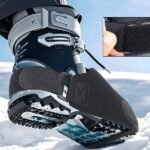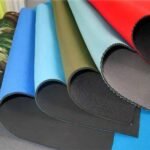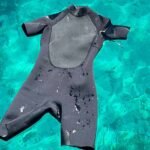If you love swimming in open water, you know how cold it can get. Cold water swimming is exciting, but it can also be dangerous without the right gear. Many swimmers want to stay warm and safe, but they don’t know which wetsuit to choose. That’s where this guide comes in. In this article, we’ll walk you through everything you need to know to choose the best wetsuit for swimming in cold water.
What Is A Wetsuit And How Does It Work In Cold Water?
A wetsuit is a piece of clothing made from neoprene. It is worn by swimmers, surfers, and divers. The purpose of a wetsuit is to keep your body warm in cold water.
The wetsuit works by trapping a thin layer of water between your skin and the neoprene. Your body heats up this layer of water, creating insulation. Neoprene is also a poor conductor of heat, which helps retain your body warmth.
Thicker wetsuits provide more warmth. Full-body wetsuits offer better protection than short ones. Special seams and linings also help reduce cold water entering the suit.
Which Factors Should You Consider When Choosing A Wetsuit For Cold Water Swimming?

When selecting a wetsuit for cold water, there are a few key factors to think about:
- Water temperature
- Wetsuit thickness
- Fit and flexibility
- Seam construction
- Zipper type
- Material quality
- Extra thermal lining
Let’s look at these in a simple comparison table:
| Factor | What To Look For |
|---|---|
| Water Temperature | Check the average temp of the location |
| Thickness | 3/2mm to 6/5/4mm based on conditions |
| Fit | Snug but not tight |
| Flexibility | Allows comfortable movement |
| Seam Type | GBS, taped, or sealed seams |
| Zipper | Chest zip or back zip |
| Thermal Lining | Adds extra warmth |
Each factor affects how well the wetsuit keeps you warm and how easy it is to swim.
What Suit Is Best For Cold Water Swimming?

The best suit for cold water swimming is a full-body wetsuit with proper thickness and thermal lining.
A full-body wetsuit covers your arms and legs. This helps you stay warm longer.
Look for wetsuits made for open water swimming. They are designed for longer use and better movement. Some triathlon wetsuits also work well, but only if they are thick enough.
Choose a wetsuit with:
- 4/3mm to 6/5/4mm thickness
- Chest zip or zipperless for less water entry
- Thermal lining inside
- Glued and blind-stitched seams
- Smooth skin outer panels to block wind chill
Brands often design cold water wetsuits with extra care. If you swim often or for long distances, invest in a high-quality suit.
What Thickness Wetsuit For Cold Water Swimming?
Wetsuit thickness is one of the most important choices. The colder the water, the thicker the suit you need.
Here is a basic guide:
| Water Temperature | Recommended Wetsuit Thickness |
|---|---|
| 18°C – 22°C (64°F – 72°F) | 2/2mm or 3/2mm |
| 14°C – 17°C (57°F – 63°F) | 4/3mm |
| 10°C – 13°C (50°F – 56°F) | 5/4mm or 5/4/3mm |
| Below 9°C (48°F) | 6/5/4mm + hood, gloves, boots |
The first number refers to the thickness on the torso. The second and third (if shown) are for the arms and legs.
For very cold water, consider wetsuits with integrated hoods and extra gear.
Are There Specific Materials That Perform Better In Cold Water?

Yes. The material of the wetsuit affects how warm and flexible it is.
Most wetsuits are made from neoprene. For cold water, choose wetsuits made with high-quality, closed-cell neoprene. This type has better insulation.
Some advanced wetsuits use limestone-based neoprene, which is lighter and warmer than petroleum-based types.
Also look for wetsuits with:
- Thermal or fleece linings inside
- Smooth skin neoprene on the chest and back
- Sealed seams that stop water entering
These materials help your body stay warm longer in icy water.
How Should A Wetsuit Fit For Cold Water Swimming?
A good fit is important. A wetsuit that is too loose lets cold water rush in. One that is too tight restricts your movement and breathing.
Here are some basic fit tips:
- It should feel snug like a second skin
- No big wrinkles, gaps, or loose areas
- Should allow full range of motion
- Try lifting your arms and bending your knees
Different brands have different size charts. Always check them before buying. If you swim often or have special needs, a custom-fit wetsuit may be the best choice.
Do You Need Additional Gear With Your Wetsuit For Extreme Cold?
Yes. In very cold water, a wetsuit alone may not be enough. You may need extra gear to stay warm and safe.
Here is a list of additional items:
| Item | Purpose |
|---|---|
| Neoprene hood | Keeps head and ears warm |
| Neoprene gloves | Protects hands from cold |
| Neoprene boots | Keeps feet warm and adds grip |
| Thermal base layer | Adds insulation under the suit |
| Wetsuit vest | Optional extra warmth for torso |
These accessories help you swim longer and avoid hypothermia. They are a must in water below 10°C (50°F).
Which Types Of Cold-Water Swimmers Need Specialized Wetsuits?
Not all swimmers have the same needs. The type of wetsuit depends on your activity and how long you stay in the water.
Here are some examples:
Open Water Swimmers
Need full wetsuits with smooth skin panels and high flexibility. They swim for long periods and need warmth and comfort.
Triathletes
Prefer suits with a balance of warmth and speed. Wetsuits should be easy to take off during races.
Divers
Use thicker suits with extra insulation. They stay still longer underwater and lose heat faster.
Surfers
Need suits that allow freedom of movement. Extra reinforcement on knees and elbows is helpful.
Rescue Teams / Military
Require high-performance wetsuits. Durability, protection, and custom features are key.
If you are a brand serving any of these markets, it is smart to offer styles tailored to these user groups.
Conclusion
Choosing the best wetsuit for swimming in cold water is about more than just warmth. You must look at water temperature, fit, material, thickness, and extra gear. A wetsuit that fits well and is made with quality materials will keep swimmers safe, warm, and comfortable.
At Szoneier, we specialize in manufacturing high-quality wetsuits for cold water swimming. We offer custom and wholesale services for brand owners, wholesalers, and medium-to-large retailers in Europe and North America. Our team can help you create wetsuits that meet your specific needs, from material selection to sizing, logos, and packaging.











